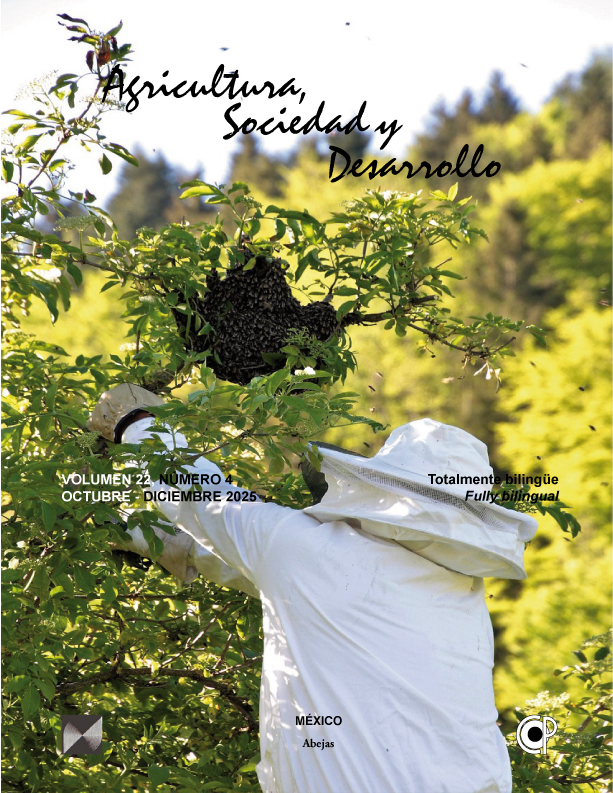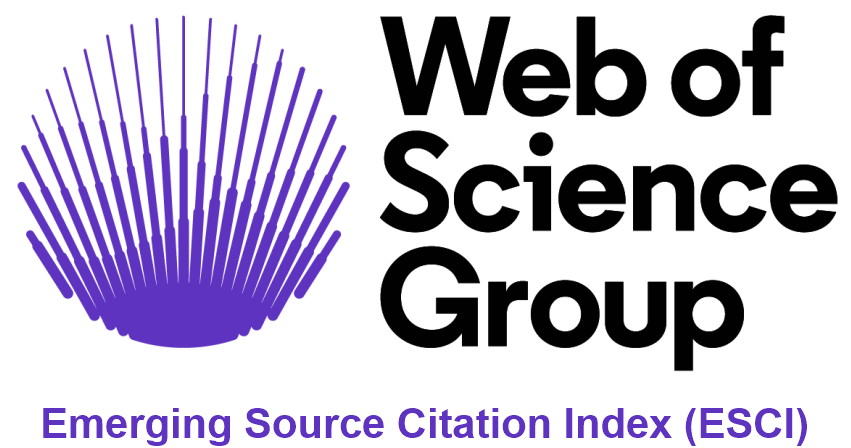Sub-sectors related to the agricultural sector and to demand from the United States of America.
DOI:
https://doi.org/10.22231/asyd.v22i4.1719Keywords:
co-integration, demand, government support, mexican agricultural sector, mexican industrial sectors, North AmericaAbstract
In this article, we aim to determine the relationship between various industrial subsectors linked to Mexico’s agricultural sector, as well as to demand in the United States. Twenty co-integration tests and four data panels were implemented in five subsectors linked to Mexico’s agricultural sector and to demand in the United States. The latter is represented by consumption expenditure and personal income in the United States. Results from co-integration tests indicate that the subsectors linked to Mexico’s agricultural sector are not co-integrated with consumption expenditure and personal income in the United States; and the data panels corroborate the results from the co-integration tests. We conclude that the subsectors linked to Mexico’s agricultural sector are not co-integrated with demand from the United States of America despite trade agreements, and that although Mexico’s agricultural sector is co-integrated with demand from the United States of America; this does not benefit its subsectors. Therefore, areas of opportunity still exist, where policies could be created to support producers, so they can co-integrate with demand from the United States of America, and where those sectors that are already co-integrated can create production chains and benefit other sectors and subsectors.
References
Anguiano J, Ruiz A. 2022. Determinantes de la sincronización de los ciclos económicos en América del Norte. Estudios de Economía. 49(1). 63-89. http://dx.doi.org/10.4067/S0718-52862022000100063. DOI: https://doi.org/10.4067/S0718-52862022000100063
BEA - Bureau for Economics Analysis del U.S. Department Of Commerce. 2024. Data Archive: Gross Domestic Product by Industry and Input-Output Statistics. https://apps.bea.gov/histdata/histChildLevels.cfm?HMI=8&_gl=1*150p4xg*_ga*MzAzMjYwNjguMTcwM-DUxNT-MwNw..*_ga_J4698JNNFT*MTcwMDUxNTMwNy4xLjEuMTcwMDUxNTczOS4wLjAuMA (Recuperado: enero 2024).
Benítez OB. 2022. Influencia de los factores climáticos en la producción de maíz en México. El Semestre de las Especializaciones. 3(2). 83-112. https://www.depfe.unam.mx/especializaciones/revista/3-2-2022/03_EAE_Benitez-Lopez_2022.pdf.
Brambila JJ, Martínez MÁ, Rojas MM, Pérez V. 2014. El valor de la producción agrícola y pecuaria en México: fuentes del crecimiento, 1980-2010. Revista Mexicana de Ciencias Agrícolas. 5(4). 619-631. https://www.scielo.org.mx/scielo.php?script=sci_arttext&pid=S2007-09342014000400007. DOI: https://doi.org/10.29312/remexca.v5i4.923
Cardona M, Barrero YM, Gaviria CF, Álvarez EH, Muñoz JC. 2007. Aportes teóricos al debate de la agricultura desde la economía. Borradores Departamento de Economía. (27). 1-17. https://bibliotecadigital.udea.edu.co/entities/publication/82645cf9-6aae-46ef-9755-45a53937a804.
Chávez A, Ramírez N, Rodríguez DE. 2019. Del Tratado de Libre Comercio de América del Norte (TLCAN) al Tratado entre México, Estados Unidos y Canadá (T-MEC) y sus diferencias. Revista Contribuciones a la Economía. 17(4). 1-13. https://dialnet.unirioja.es/servlet/articulo?codigo=8957852.
Fernández DA. 2008. El fuelle del estado: sobre la incidencia de las políticas públicas en la concentración de la producción agrícola pampeana (1989-2001). Documentos del CIEA. (3). 33-67. https://www.ciea.com.ar/web/wp-content/uploads/2016/11/Doc3_2.pdf
García A. 2020. El sector agropecuario y el desarrollo económico: el caso cubano. Economía y Desarrollo. 164(2). e5. https://www.redalyc.org/journal/4255/425565064005/html/.
González H. 2017. La exportación de frutas y hortalizas de México a América del Norte: 1980-2015, 1ª ed.; Universidad de Guadalajara (UDG): México; pp: 1-149.
Gujarati DN, Porter DC. 2010. Econometría, 5ª ed.; McGraw Hill: México.
Hernández D, Alejos AA, Casique A. 2021. Impacts on Profitability for the Mexican 8 Strawberry Producers Due to an Increase in Exports to USA. International Journal of Agricultural Economics. 6(1). 1-11. https:/doi.org/10.11648/j.ijae.20210601.11. DOI: https://doi.org/10.11648/j.ijae.20210601.11
Hernández D, Casique A, González JP. 2022a. Determination of the Economic Viability of Increasing Exports of Mexican Mango to the Canadian Market. International Journal of Agricultural Economics. 7(4). 163-174. https://www.sciencepublishinggroup.com/article/10.11648/10071096.
Hernández D, Cornejo MC, Galvan P. 2022b. Profitability of Mexican Avocado Production in the Face of an Increase in Exports to the Canadian Market. International Journal of Applied Agricultural Sciences. 8(2). 92-103. https://doi.org/10.11648/j.ijaas.20220802.15. DOI: https://doi.org/10.11648/j.ijaas.20220802.15
Hernández D, González JP. 2022. Competitiveness Analysis of Exporting Mexican Avocado to United States of America. The Journal of Globalization, Competitiveness, and Governability. 16(1): 66-80. https://gcgjournal.georgetown.edu/index.php/gcg/article/view/4260.
Hernández D, López FJ, Casique A. 2020. A partial equilibrium analysis of Mexican mango exports to the United States. Agricultura, Sociedad y Desarrollo. 17(1). 171-199. https://doi.org/10.22231/asyd.v17i1.1327. DOI: https://doi.org/10.22231/asyd.v17i1.1327
Hernández D, Martínez MÁ. 2009. Procedure for a partial equilibrium analysis of the Mexican mango (Mangifera indica) exports to U.S.A. Revista Fitotecnia Mexicana. 32(3). 251–256. https://www.scielo.org.mx/scielo.php?pid=S0187-73802009000300013&script=sci_abstract&tlng=en. DOI: https://doi.org/10.35196/rfm.2009.3.251-256
INEGI (Instituto Nacional de Estadística y Geografía). 2024. Sistema de Cuentas Nacionales de México. Indicador Mensual de la Actividad Industrial. Año Base 2018. Serie de enero de 1993 a octubre de 2023. Series Originales/ Índice de volumen físico base 2018=100. INEGI IMAE. México. https://www.inegi.org.mx/temas/imai/#tabulados (Recuperado: enero 2024).
Infante ZT, López AJ. 2019. El trinomio de ventajas comparativas reveladas en la canasta básica de la Sader en América del Norte. The Anáhuac Journal. 19(2). 39-69. https://doi.org/10.36105/theanahuacjour.2019v19n2.02. DOI: https://doi.org/10.36105/theanahuacjour.2019v19n2.02
Infante ZT, Ortega P, López AJ. 2021. Competitividad de los productos agrícolas estratégicos de México en América del Norte. Repositorio de la Red Internacional de Investigadores en Competitividad. 14. 1-20. https://riico.net/index.php/riico/article/view/1932.
Jaime R, Hurtado BA, Romero NG. 2015. La competitividad en la exportación de espárragos sonorense hacia estados unidos en el marco del TLCAN. Revista Mexicana de Agronegocios. 36. 1265-1274. https://www.redalyc.org/pdf/141/14132408012.pdf.
Nava KM. 2021. La colaboración del sector privado en la renegociación del Tratado de Libre Comercio de América del Norte. Análisis de la industria automotriz Mexicana. CienciaUAT, 15(2). 102-121. https://doi.org/10.29059/cienciauat.v15i2.1427. DOI: https://doi.org/10.29059/cienciauat.v15i2.1427
OCDE-FAO (Organización para la Cooperación y el Desarrollo Económicos-Organización de las Naciones Unidas para la Agricultura y la Alimentación). 2011. Perspectivas de la agricultura 2011-2020. OECD Publishing y FAO. http://herzog.economia.unam.mx/lecturas/inae2/u3l1.pdf .
OMC (Organización Mundial del Comercio). 2017. Informe sobre el comercio mundial 2017, comercio, tecnología y empleo. OMC: Suiza, Ginebra. https://www.wto.org/spanish/res_s/booksp_s/world_trade_report17_s.pdf.
Pérez A, Caamal I, Pat VG, Martínez D, Reza J. 2019. Influencia de adopción de tecnología y la mano de obra en la eficiencia productiva en el sector agrícola de México, 1979-2014. Acta Universitaria. 29. 1-15. https://doi.org/10.15174/au.2019.1631. DOI: https://doi.org/10.15174/au.2019.1631
Pérez M. 2019. Vínculos productivos en América del Norte. Naciones Unidas, Comisión Económica para América Latina y el Caribe (CEPAL): México, https://www.cepal.org/es/publicaciones/44609-vinculos-productivos-america-norte. pp: 1-48.
Polaski S. 2006. Perspectivas sobre el futuro del TLCAN: la mano de obra mexicana en la integración de América del Norte. Universidad Nacional Autónoma de México, Coordinación de Humanidades, Centro de Investigaciones sobre América del Norte: México, https://ru.micisan.unam.mx/handle/123456789/20946. pp: 35-56.
Puchet M, Moreno JC, Ruiz P. 2011. La integración regional de México: condicionantes y oportunidades por su doble pertenencia a América del Norte y a Latinoamérica. Economía UNAM. 8(23). 3-36. https://www.scielo.org.mx/scielo.php?pid=S1665-952X2011000200001&script=sci_abstract&tlng=es.
Puyana A. 2020. Del Tratado de Libre Comercio de América del Norte al Acuerdo México-Estados Unidos-Canadá. ¿Nuevo capítulo de la integración México-Estados Unidos? El Trimestre Económico. 87(347). 635-668. https://doi.org/10.20430/ete.v87i347.1086. DOI: https://doi.org/10.20430/ete.v87i347.1086
Ramírez JJ. 2021. El proyecto transregional de la administración Trump y la competencia por la integración económica en el Pacífico. México y la Cuenca del Pacífico. 10(30). 33-56. https://doi.org/10.32870/mycp.v10i30.748. DOI: https://doi.org/10.32870/mycp.v10i30.748
Roitbarg HA. 2021. Factores detrás del aumento de precios en el sector agrícola a inicios del siglo XXI: rentas, salarios, petróleo y productividad. Desarrollo y Sociedad, (88). 169-199. https://doi.org/10.13043/DYS.88.5. DOI: https://doi.org/10.13043/DYS.88.5
Rosenzweig A. 2005. El debate sobre el sector agropecuario mexicano en el Tratado de Libre Comercio de América del Norte. Unidad Agrícola de la sede subregional de la CEPAL, Naciones Unidas en México: México, https://www.cepal.org/es/publicaciones/4951-debate-sector-agropecuario-mexicano-tratado-libre-comercio-america-norte. pp: 1-88.
Santa A. 2019. La política de Enrique Peña Nieto hacia América del Norte: normalización e institucionalización. Foro Internacional. 59(3-4). 703-731. https://doi.org/10.24201/fi.v59i3-4.2638 DOI: https://doi.org/10.24201/fi.v59i3-4.2638
Suriaga MA, Hidalgo WA. 2021. Pinceladas del comercio Internacional. E-IDEA Journal of Business Sciences. 3(13). 27-43. https://doi.org/10.53734/eidea.vol3.id142. DOI: https://doi.org/10.53734/eidea.vol3.id142
Tonconi J. 2015. Producción agrícola alimentaria y cambio climático: un análisis económico en el departamento de Puno, Perú. Idesia (Arica). 33(2). 119-136. https://www.scielo.cl/scielo.php?script=sci_arttext&pid=S0718-34292015000200014. DOI: https://doi.org/10.4067/S0718-34292015000200014
Wooldridge J. 2010. Introducción a la econometría: un enfoque moderno (7a.ed.); Cengage Learning Editores: México, DF, https://herioscarlanda.wordpress.com/wp-content/uploads/2018/10/wooldridge-2009-introduccic3b3n-a-la-econometrc3ada-un-enfoque-moderno.pdf. 865 p.
Published
How to Cite
Issue
Section
License
Copyright (c) 2025 Humberto Banda Ortiz, Luis Miguel Cruz Lázaro, Omar Bautista Hernández

This work is licensed under a Creative Commons Attribution-NonCommercial 4.0 International License.
Authors who publish in this journal accept the following conditions:
- The authors retain the copyright and transfer to the magazine the right of the first publication, with the work registered with the Creative Commons attribution license, which allows third parties to use what is published as long as they mention the authorship of the work and the first publication in this magazine.
- Authors may make other independent and additional contractual arrangements for non-exclusive distribution of the version of the article published in this journal (e.g., including it in an institutional repository or publishing it in a book) as long as they clearly indicate that the work It was first published in this magazine.
- Authors are permitted and encouraged to publish their work on the Internet (for example on institutional or personal pages) before and during the review and publication process, as it can lead to productive exchanges and greater and faster dissemination of the work. published (see The Effect of Open Access).













